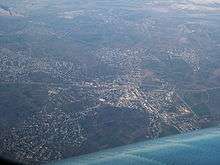Şərur
| Sharur Şərur | |
|---|---|
| City & Municipality | |
 Sharur | |
| Coordinates: 39°32′45″N 44°58′20″E / 39.54583°N 44.97222°E | |
| Country |
|
| Autonomous republic | Nakhchivan |
| Rayon | Sharur |
| Population (2008)[1] | |
| • Total | 6,964 |
| Time zone | AZT (UTC+4) |
| Area code(s) | +994 892 |
Şərur Şəhəri (En: Sharur City, formerly Bashnorashen, Norashen (1930-1964), Iliich (Ильич) and Il'ichëvsk (Ильичёвск) (1964–1991) after Vladimir Ilyich Lenin) is the capital town and most populous municipality of Sharur Rayon in Nakhchivan Autonomous Republic of Azerbaijan. It is located 66 km in the north-west from the Nakhchivan city, on the Sharur plain. It has a population of 6,964 people.

Despite the exact establishment date of Sharur, has not yet been defined, it is known that this settlement yet settled in the millennium of BC. The name of the Sharur settlement, mentions at the epos of the "The Book of Dede Korkut" as Şəruk (Sharuk). Because the ancient Sharur settlement remained under modern buildings, didn't conducted extensive archaeological research. The construction of the modern office buildings and the five-storey buildings in the place of the 1-2 floors old buildings, has been played an important role to the becoming a modern city of the Sharur. The reconstruction works has been done in the city and were built the buildings in modern architecture, art school, cultural palace, communication center, building of the executive power, the history-ethnography museum, railway station, school buildings. There are three secondary schools, college, music school, three kindergartens, a central hospital, private hospital and diagnostic center, mosque, electricity networks center, two shopping centers, cinema in the Sharur. The stadium was built (1981), also the Alley of Martyrs has been laid. The park has been established and a monument has been erected in honor of the national leader Heydar Aliyev, in the main square of the city center.[2] It was the administrative center of Sharur-Daralagez uyezd of the Russian empire (1870-1917).[3]
Etymology
The name of the settlement is related with the name of the Şərur Plain. The name of the plain for the first time was mentioned in the ancient sources of the V century and in the epos of the "The Book of Dede Korkut". In the toponomy of the Turkish-speaking peoples, the component of şar/şər/şer is used in meaning "arm", "tributary of river", "waterfall", "the river which connecting the two tributaries in one", and the component of Ur means "water" in content of hydronyms. It can be assumed that the name of the plain was created in regarding on the separation of the Eastern Arpachay River into the many tributaries in the area.[4]
Population
According to official information of The State Statistical Committee of the Republic of Azerbaijan, on the date of January 1, 2013, in the city has a population of about 7 thousands.[5]
Ethnic groups
| Ethnic group |
January 17–23, 1939.[6] | January 15–22, 1959.[7] | January 15–22, 1970.[8] | January 17–24, 1979.[9] | ||||
|---|---|---|---|---|---|---|---|---|
| Number | % | Number | % | Number | % | Number | % | |
| total | 659 | 100.00 | 1 377 | 100.00 | 2 282 | 100.00 | 3 285 | 100.00 |
| Azerbaijani | 351 | 53.26 | 1 214 | 88.16 | 2 125 | 93.12 | 3 131 | 95.31 |
| Russian and Ukrainian | 140[10] | 21.24 | 81[11] | 5.88 | 106 | 4.65 | 112 | 3.41 |
| Armenian | 129 | 19.58 | 63 | 4.58 | 29 | 1.27 | 27 | 0.82 |
| Kurd | 2 | 0.30 | ... | ... | 13 | 0.57 | 7 | 0.21 |
| Georgian | ... | ... | 1 | 0.07 | 2 | 0.09 | 1 | 0.03 |
| Tatar | ... | ... | ... | ... | 2 | 0.09 | ... | ... |
| Avar | ... | ... | ... | ... | 1 | 0.04 | ... | ... |
| German | 5 | 0.76 | ... | ... | ... | ... | ... | ... |
| Lezghin | 5 | 0.76 | ... | ... | ... | ... | ... | ... |
| Jewish | 1 | 0.15 | ... | ... | ... | ... | ... | ... |
| others | 25 | 3.79 | 18 | 1.31 | 4 | 0.18 | 7 | 0.21 |
Notable natives
- Arthur Voloshin — Hero of Russia.[12]
Twin Towns
References
- ↑ World Gazetteer: Azerbaijan – World-Gazetteer.com
- ↑ ANAS, Azerbaijan National Academy of Sciences (2005). Nakhchivan Encyclopedia. volume II. Baku: ANAS. p. 308. ISBN 5-8066-1468-9.
- ↑ Brockhaus and Efron Encyclopedic Dictionary
- ↑ Encyclopedic dictionary of Azerbaijan toponyms. In two volumes. Volume I. p. 304. Baku: "East-West". 2007. ISBN 978-9952-34-155-3.
- ↑ The State Statistical Committee of the Republic of Azerbaijan
- ↑ Ethno-Caucasus, Этнодемография Кавказа: Население Баш-Норашенского района (по переписи 1939-го года)
- ↑ Ethno-Caucasus, Этнодемография Кавказа: Население Норашенского района (по переписи 1959-го года)
- ↑ Ethno-Caucasus, Этнодемография Кавказа: Население Ильичевского района (по переписи 1970-го года)
- ↑ Ethno-Caucasus, Этнодемография Кавказа: Население Ильичевского района (по переписи 1979-го года)
- ↑ 129 of them were Russians, and Ukrainians were 11 persons.
- ↑ All of them were ethnic Russians.
- ↑ Волошин Артур Владимирович (in Russian). Heroes of the country.
.svg.png)